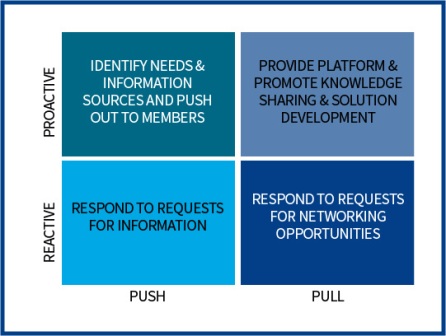If you’re an Association CEO are you thinking about the next recession? Since 1947 historical data shows a recession, averaging every 6-7 years in the United States. With a U.S. recovery in 2009 might 2015 or 2016 be the time frame when the next recession occurs? Even though economic forecasting can be inconclusive, being ready for the next downturn might be a prudent move for Associations.
9
Dec
18
Nov

Member Outcome Focused Training
In a climate of disruptive innovation and tight operating margins where can companies look for education and training solutions? Quite simply it’s Associations, as they have the ability to facilitate new solutions to address evolving member business outcomes. While the traditional Association model “pushes” out training and education programs, innovative organizations structure these products to help members achieve their business outcomes.
10
Nov

Pro Active Knowledge Sharing
In an increasingly competitive and low profit margin world companies only invest time, money, and staff resources where they can drive business outcomes. With fewer dollars to spend, today’s executives look past yesterday’s Association model and instead seek out strategic partners.
22
Oct

Association Alignment Can Drive Growth
Engaging boards in strategy development is powerful; the strategic member engagement survey (see results http://bit.ly/1g8g1J2) reports that those Associations who have this capability more often report upward 3 Year business trends. However, when actionable member data (through impact surveys) is discussed with boards, it helps Association’s create great conversations on how to align with their member’s business outcomes.
17
Oct
Association Outcomes Trump Outputs
Association Outcomes Trump Outputs. Emerging from the great recession and experiencing an almost 50% drop in conference attendance, the Cable & Telecommunications Association for Marketing moved to realign its focus on member business outcomes. Like many Associations today, members are under pressure to produce results for their companies and their focus is about “outcomes” for themselves, their organizations, their constituencies, and customers. An association’s “outputs” (conferences, journals, etc.) are just mechanisms and tactics; members demand “outcomes.”
Members Demand Outcomes
When members don’t feel that they can impact something that they care about, they form their own coalitions, forums and on line communities outside of the association. Too often an association’s internal discussions are about tweaking “outputs,” not creatively driving the “outcomes” that members really care about. In a number of cases Associations shift their focus in order to satisfy member’s new expectations.
Zell Murphy, Senior Vice President, Finance & Administration at CTAM: Cable & Telecommunications Association for Marketing http://www.ctam.com says he and his colleagues needed to shift their focus in order to align with their members business objectives.
Actionable Data
It’s essential to understand how an association is currently impacting member objectives. This requires securing actionable data about member perceptions of their environmental and operational challenges. Murphy agrees and emphasizes that CTAM utilizes survey data and ongoing member contact to define the level of impact they require to achieve their business outcomes. He notes that his members defined the level of strategic collaboration they expected.
Association Outcomes Trump Outputs
With a shared focus on outcomes, many members want to contribute and be connected if they believe that business objectives will be achieved. CTAM reports improvements in renewals and new member discussions much different from: “what do I get for my dues?” conversations before the changes. Although there is only modest operating growth, it reverses what might have been a downward spiral had they not shifted from an output to an outcome focus.
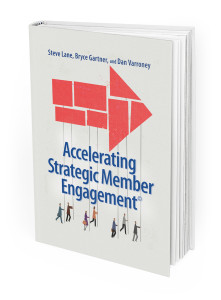 Free eBook “Accelerating Strategic Member Engagement” is available for all Association Executives at www.potomaccore.com, www.icimo.com, and www.verticalleapconsulting.com.
Free eBook “Accelerating Strategic Member Engagement” is available for all Association Executives at www.potomaccore.com, www.icimo.com, and www.verticalleapconsulting.com.
8
Oct
Predicting Engagement Potential
Strategic member engagement means data driven decisions. By segmenting your audience you can begin to understand each group’s priorities. What are the outcomes they seek? How do they participate with your association today? What can you learn about them via the social media they embrace?
Audience segmentation will vary from association to association. Common examples include: company size, location, the engaged individual’s role, scope of responsibility and career stage, their types of engagement, the challenges faced, and special interests. Some Associations also identify which members utilize competitor Associations.
Segmented Communication And Engagement Tactics
Segmentation drives Association communication and engagement strategies and mechanisms. Associations must avoid continually sending everything to all constituencies, and wondering why there are so few “click throughs” (including by your volunteer leaders). Understanding your constituency segments also helps staff better determine:
- When to use “push” tactics (e.g. education, product sales)
- When to use “pull” tactics that encourage knowledge contribution and collaboration behaviors
- When to use influencing strategies (e.g. with Legislators, Regulators, the media)
Think in terms of primary and secondary approaches, not one size fits all.
Develop Member Segment Profiles
Don’t expect to move every segment to a higher level of engagement. Look for the segments that you most desire to have contributing to the collective body of knowledge and the development of new solutions. Also identify those segments that most drive your evolving business model.
Predicting Engagement Potential
According to the Strategic Member Engagement Survey© , only 46% of executives from professional societies and 53% from trade associations report they have identified a segment of their core membership that most wants to contribute their knowledge and collaborate. Those who report that they positively identify such a segment more often report an upward trend in 3 year annual revenue.
 Free eBook “Accelerating Strategic Member Engagement” is available for all Association Executives at www.potomaccore.com
Free eBook “Accelerating Strategic Member Engagement” is available for all Association Executives at www.potomaccore.com
1
Oct
Engagement and Moving to We
Engagement and Moving to We. Moving to “we” is about inclusiveness and being open to the possibilities that might surface. This requires an integrated blend of “push” and “pull” offerings, with the explicit expectation that together “we” make great things happen for members.
“We/You” Fallacy
There is a fundamental flaw in the approach of many associations. Everything, whether spoken, written, or inferred, says: “here is what we do for you”. And in their attempt to demonstrate that staff and volunteer leaders do care what members think, associations tend to be far more reactive than proactive. Worse yet, some shy away from asking members what they really want for fear they might actually get that feedback. Not everyone wants to have their views challenged, especially if they have spent years executing on those views/assumptions.
Understanding an Association’s alignment with member needs includes assessing the relationships between staff, volunteer leaders, and other members. Most association executives view this interface through a lens of “we/you”. The evolving association model is all about “we”.
Foundation
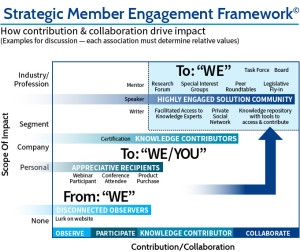 The Strategic Engagement Framework© is built upon the relationship between increasing levels of membership impact while increasing levels of contribution and connectedness. Associations (especially those facing stiff competition) are recognizing that member engagement strategies are a true differentiator and game changer.
The Strategic Engagement Framework© is built upon the relationship between increasing levels of membership impact while increasing levels of contribution and connectedness. Associations (especially those facing stiff competition) are recognizing that member engagement strategies are a true differentiator and game changer.
To be relevant then, Associations should help members collaborate to achieve something they care about. Use the Strategic Engagement Framework (below) to reinforce a balanced blend of member behaviors that collectively result in optimal association impact.
Engagement and Moving to We
People value and make contributions to activities that help them achieve something they care about. Treating each member as having a piece of the puzzle because the association’s job is to facilitate 24/7 knowledge sharing leads to innovative solutions which drive member their business outcomes.
 Free eBook “Accelerating Strategic Member Engagement” is available for all Association Executives at www.potomaccore.com, www.icimo.com, and www.verticalleapconsulting.com.
Free eBook “Accelerating Strategic Member Engagement” is available for all Association Executives at www.potomaccore.com, www.icimo.com, and www.verticalleapconsulting.com.
24
Sep
Members Feel Connected?
Members Feel Connected? With year end approaching, member retention may loom large for any Association. Understanding why members leave gets to the heart of issues like retention and member connectedness. Connectedness is the critical organizational outcome that drives long term success, and unlike “loyalty,” it can be measured in behavioral terms. The 3 C’s capture how member knowledge “contributions” lead to “collaboration” and also stimulate and reinforce “connectedness”.
Why Members Leave
In the Strategic Member Engagement survey (http://bit.ly/1g8g1J2), executives rated the frequency at which members leave for 11 potential reasons. While the ranking changed slightly, both professional society and trade association executives agreed the top 5 reasons that members leave are:
1) Insufficient perceived value (ROI)
2) Retired, changed companies, in transition
3) Joined for a one time purchase discount (e.g. meeting registration)
4) Acquired by another company that won’t pay the dues
5) Insufficient connection to their business/professional objectives
Connectedness
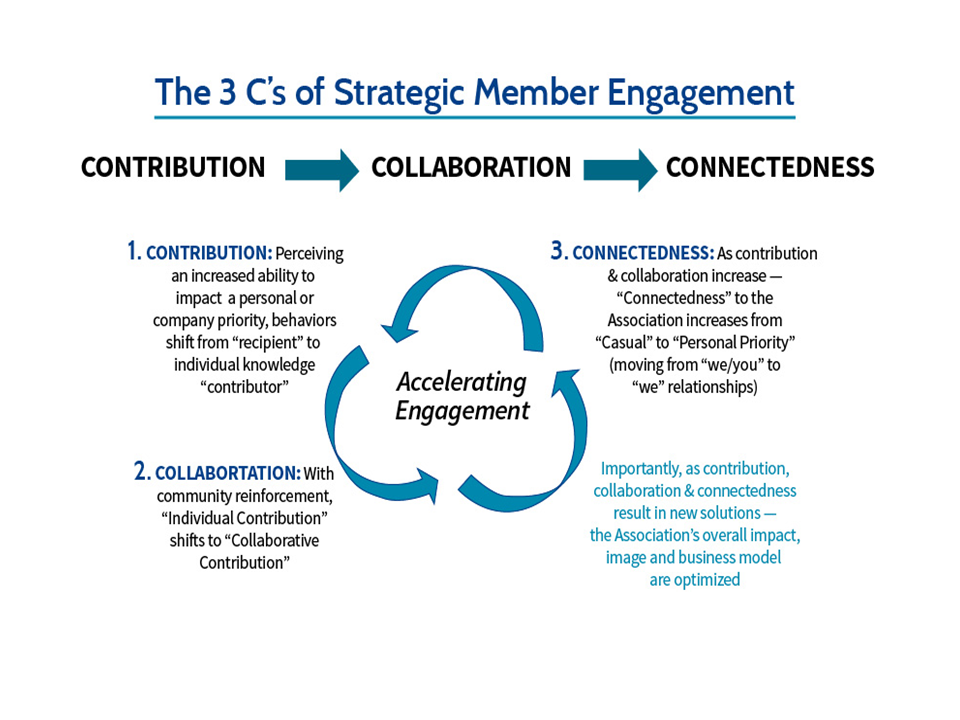 As shown in the graphic above, if an Association member perceives an opportunity to have an impact upon something he/she cares about, behaviors start to change from being a Recipient to a Knowledge Contributor. And for some, individual contribution that is recognized and openly appreciated leads to Solutions Collaboration with other knowledge contributors.
As shown in the graphic above, if an Association member perceives an opportunity to have an impact upon something he/she cares about, behaviors start to change from being a Recipient to a Knowledge Contributor. And for some, individual contribution that is recognized and openly appreciated leads to Solutions Collaboration with other knowledge contributors.
This is the point at which association magic begins! It’s when contributions and collaboration evolve into a sense of belonging that is called “Connectedness” ( http://bit.ly/1ATwwUe).
Members Feel Connected?
Members leave when they perceive insufficient value, insufficient connection to their business/personal objectives, insufficient opportunity to have an impact, or they really don’t want a bundled package of offerings and only joined for a discount.
Association’s driving member connectedness with the 3 C’s (contribute, collaborate, connect) provide differentiated member value and are better positioned to accelerate their retention and overall financial performance.
 Free eBook is available for all Association Executives at www.potomaccore.com, www.icimo.com, and www.verticalleapconsulting.com.
Free eBook is available for all Association Executives at www.potomaccore.com, www.icimo.com, and www.verticalleapconsulting.com.
17
Sep
Keeping Members Engaged
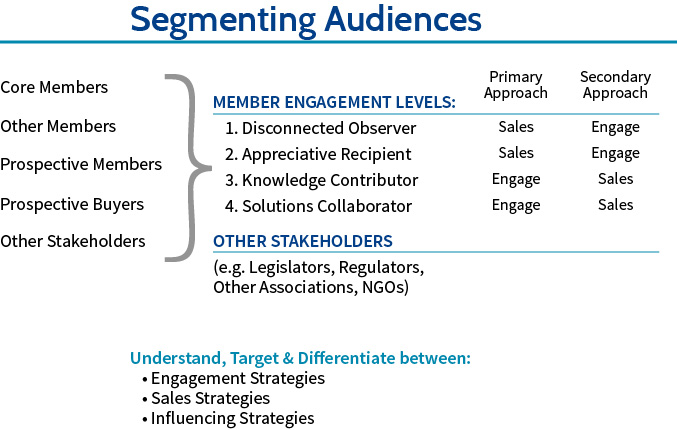
People only contribute time, knowledge, and ideas when they perceive an opportunity to impact the outcomes they seek. Keeping and winning higher engagement levels happens when Associations create ongoing opportunities for their constituencies to contribute knowledge and collaborate with other members.
Assess your Association’s constituency segments within the following 4 level framework. For example:
- Disconnected Observer. Lurking on website or on-line community, communications scanner, congressional staff, the general public
- Appreciative Recipient. Event attendee, subscriber, product purchaser, ad/exhibit/sponsorship purchaser
- Knowledge Contributor. Speaker, writer, availability as a knowledge expert, mentor. This can also be the constituent that translates or transfers knowledge between stakeholders
- Solutions Collaborator. Board, committees, roundtables, special interest groups, legislative campaign
Steps To Keeping Members Engaged
The following steps will help keep members engaged:
- Understand the 4 levels of engagement & look for constituency segments that are primarily distinguished by one or two (of the 4) levels.
- Identify member behaviors that impact the industry or profession.
- Create opportunities for members to engage in the design of new solutions that drive member outcomes.
- Success is measured in member behaviors that motivate connectedness. Target high probability segments to move to higher levels of engagement.Differentiate the “experience” at the national level and understand which member segments are best served at the local level.
Keeping Members Engaged
Everyone is busier than ever, especially as associations emerge from the recession and continually shift their attention to growth strategies. As such, people will only contribute time, knowledge, and ideas when they perceive an opportunity to impact the outcomes they seek. Keeping members engaged begins with understanding the 4 levels of engagement.
 Free eBook “Accelerating Strategic Member Engagement” is available for all Association Executives at www.potomaccore.com
Free eBook “Accelerating Strategic Member Engagement” is available for all Association Executives at www.potomaccore.com
11
Sep
Member Value Drivers?
 Member Value Drivers? Too often an association’s internal discussions are about tweaking “outputs” and not creatively driving the “outcomes” that members really care about. This only fuels the “we/you” culture that exists in so many associations. Associations can get into trouble when internal discussions infer “we know what’s best for our members”. If members don’t feel that they can impact things that they care about, they form coalitions and on line communities outside of the association. (http://bit.ly/1qEaS3H)
Member Value Drivers? Too often an association’s internal discussions are about tweaking “outputs” and not creatively driving the “outcomes” that members really care about. This only fuels the “we/you” culture that exists in so many associations. Associations can get into trouble when internal discussions infer “we know what’s best for our members”. If members don’t feel that they can impact things that they care about, they form coalitions and on line communities outside of the association. (http://bit.ly/1qEaS3H)
Outcome Focus and Member Value Drivers
Members only care about “outcomes” that address their business and professional challenges and opportunities (See ROI TO R.O.M.E. http://bit.ly/1nCFqiU). Change the conversation from selling and testing satisfaction with association outputs (conference, journal, etc.) to engaging members in ways that facilitate knowledge sharing and collaboration with other members.
Up At Night Issues
Whether obtained via survey, focus groups, interviews, roundtables, online community dialogue, social media tracking or other mechanisms, it’s essential to understand how an your association is currently impacting member objectives. This requires securing actionable data about member perceptions of their environmental and operational challenges. If these issues aren’t surfaced, Associations may not be asking the right questions.
Member Impact Surveys
Associations should utilize impact surveys instead of satisfaction surveys as impact surveys are forward looking. They focus on the desired future outcomes that members seek to address their “up at night” issues.
Member Value Drivers?
Strategic member engagement begins with changing the conversation from “outputs” to “outcomes”. An “outcomes” focus drives member value and helps to accelerate competitive positioning and Association operating results. (http://bit.ly/1g8g1J2)
